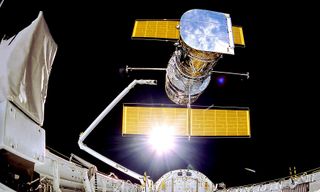NASA revives ailing Hubble Space Telescope with switch to backup computer
Hubble is back!

Editor's Note: This article has been updated to reflect new information in which Hubble has returned to science operations.
The Hubble Space Telescope has powered on once again! NASA was able to successfully switch to a backup computer on the observatory on Friday (July 16) following weeks of computer problems.
On June 13, Hubble shut down after a payload computer from the 1980s that handles the telescope's science instruments suffered a glitch. Now, over a month since Hubble ran into issues, which the Hubble team thinks were caused by the spacecraft's Power Control Unit (PCU), NASA switched to backup hardware and was able to switch the scope back on.
With Hubble back online with this backup hardware, the Hubble team is keeping a close watch to make sure that everything works correctly, according to a statement from NASA.
Read more: Hubble trouble is latest glitch in space telescope's long and storied history
Related: The Hubble Space Telescope and 30 years that transformed our view of the universe
"So far so good - just so proud of the @NASAHubble team as I received the updates all day. Assuming continued progress, Hubble will be in science mode later this weekend! Looking forward to that first "after" picture," Thomas Zurbuchen, the associate administrator for the science mission directorate at NASA tweeted following the news that Hubble was on the road to recovery.
So far so good - just so proud of the @NASAHubble team as I received the updates all day. Assuming continued progress, Hubble will be in science mode later this weekend! Looking forward to that first “after” picture.. 🛰🌌 https://t.co/waRN7gX28cJuly 16, 2021
Zurbuchen's prediction was correct. This past weekend on Saturday (July 17), Hubble's science instruments returned to operational status and the telescope was able to resume collecting science data and observing the cosmos.
Get the Space.com Newsletter
Breaking space news, the latest updates on rocket launches, skywatching events and more!
“Hubble is an icon, giving us incredible insight into the cosmos over the past three decades,” NASA Administrator Bill Nelson said in a statement following this exciting update. “I’m proud of the Hubble team, from current members to Hubble alumni who stepped in to lend their support and expertise. Thanks to their dedication and thoughtful work, Hubble will continue to build on its 31-year legacy, broadening our horizons with its view of the universe.”
Included in this switch to backup hardware, the team brought the backup PCU online as well as the backup Command Unit/Science Data Formatter (CU/SDF), which is on the other side of the Science Instrument and Command & Data Handling (SI C&DH) unit, according to the statement. The PCU diverts power to the SI C&DH while the CU/SDF formats and then sends data and commands throughout the scope.
Other pieces of hardware were also swapped to their backup versions to allow the telescope to function.
After carefully switching to the alternative hardware on Hubble, the team turned on the scope's backup payload computer, loaded it with flight software and returned Hubble to "normal operations mode," according to the statement.
In addition to monitoring the scope and its "new" hardware following this change-up, the Hubble team worked to recover Hubble's science instruments from the "safe mode" configuration that they entered following the June 13 glitch.
Getting all of the science instruments back online did, as expected, take more than a day, according to the NASA statement, because the team had to ensure that the instruments were at a stable temperature and are able to run safely.
This is not the first time that Hubble has had technical issues in space, but the telescope, which launched aboard the space shuttle Discovery in 1990, has not been serviced by astronauts since 2009, with the shuttle program ending just two years later. Despite some technical bumps in the road, like a flaw with its primary mirror that was fixed in 1993, Hubble has consistently captured some of the most breathtaking views of the cosmos ever seen.
Email Chelsea Gohd at cgohd@space.com or follow her on Twitter @chelsea_gohd. Follow us on Twitter @Spacedotcom and on Facebook.
Join our Space Forums to keep talking space on the latest missions, night sky and more! And if you have a news tip, correction or comment, let us know at: community@space.com.

Chelsea “Foxanne” Gohd joined Space.com in 2018 and is now a Senior Writer, writing about everything from climate change to planetary science and human spaceflight in both articles and on-camera in videos. With a degree in Public Health and biological sciences, Chelsea has written and worked for institutions including the American Museum of Natural History, Scientific American, Discover Magazine Blog, Astronomy Magazine and Live Science. When not writing, editing or filming something space-y, Chelsea "Foxanne" Gohd is writing music and performing as Foxanne, even launching a song to space in 2021 with Inspiration4. You can follow her on Twitter @chelsea_gohd and @foxannemusic.